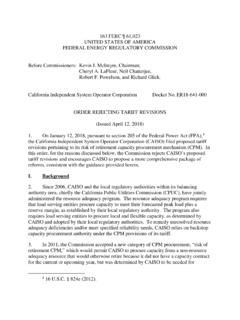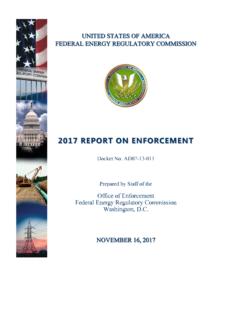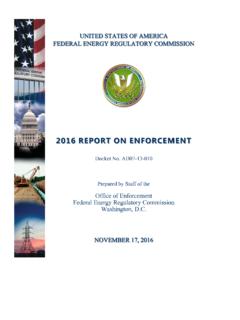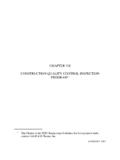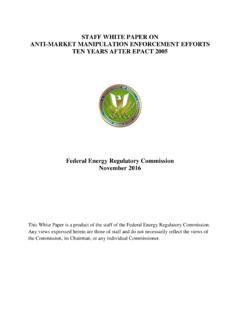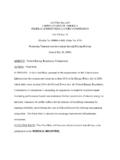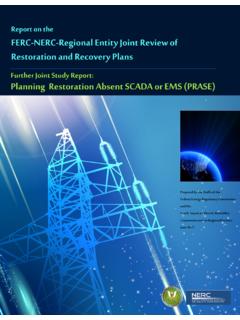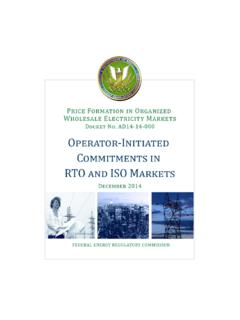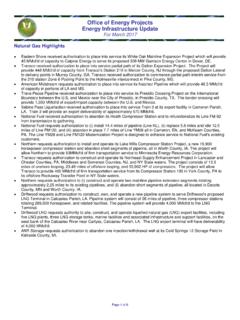Transcription of Energy Policy Act of 2005 Fact Sheet
1 FEDERAL Energy REGULATORY COMMISSION WASHINGTON, 20426 FACT Sheet AUGUST 8, 2006 Energy Policy ACT OF 2005 Significant Policy Changes The Energy Policy Act of 2005 (EPAct) is the first major Energy law enacted in more than a decade, and makes the most significant changes in Commission authority since the New Deal s Federal Power Act of 1935 and the Natural Gas Act of 1938. In passing EPAct, Congress signaled a strong vote of confidence in the Commission. The Commission has taken on new duties and authorities with a sense of purpose, mindful of the public trust they entail. Moreover, the Commission has been dedicated to meeting these obligations within the time allotted by Congress.
2 EPAct had three principal Policy goals in the areas of the statute that relate to the Commission: (1) it reaffirmed a commitment to competition in wholesale power markets as national Policy , the third major federal law in the last 30 years to do so; (2) it strengthened the Commission s regulatory tools, recognizing that effective regulation is necessary to protect the consumer from exploitation and assure fair competition; and (3) it provided for development of a stronger Energy infrastructure. EPAct granted the Commission significant new responsibilities and significant new authority to discharge these responsibilities by modifying the Federal Power Act, the Natural Gas Act and the Public Utility Regulatory Policies Act of 1978 (PURPA).
3 New Responsibilities Significant new responsibilities include: overseeing the reliability of the nation s electricity transmission grid; implementing new tools, including penalty authority, to prevent market manipulation; providing rate incentives to promote electric transmission investment; supplementing state transmission siting efforts in national interest electric transmission corridors; and reviewing certain holding company mergers and acquisitions involving electric utility facilities, a well as certain public utility acquisitions of generating facilities.
4 EPAct also specified a number of actions to be taken by the Commission. In fulfilling these requirements during the first year since EPAct was signed into law on August 8, 2005, the Commission has promulgated nine final rules, issued three additional notices of proposed rulemaking, authored and submitted seven reports to Congress, and entered into a memorandum of understanding with the Commodity Futures Trading Commission. The Commission has taken these actions in a timely manner meeting every deadline set for the Commission in EPAct.
5 Some of these deadlines were challenging, particularly the task of implementing the repeal of the Public Utility Holding Company Act of 1935 (PUHCA 1935) and promulgating a new rule to implement the Public Utility Holding Company Act of 2005, as well as implementing rules to address the Commission s expanded corporate transaction review authority under the Federal Power Act. Market Manipulation EPAct gave the Commission the authority to issue rules to prevent market manipulation in jurisdictional wholesale power and gas markets, and in jurisdictional transmission and transportation services.
6 For the Commission, this is one of the most important and challenging provisions of the Act. Congress granted this authority out of recognition that wholesale power and gas markets had changed dramatically since the 1930s. While the Commission s legal duty remains the same protecting the wholesale power and gas customer it needed additional regulatory tools to discharge this duty. EPAct gives the Commission civil penalty authority, which the Commission has indicated it will exercise carefully by assuring that its market manipulation rules are clear. That will make it easier for regulated entities to assure compliance, and make it easier for the Commission to identify violations.
7 Electricity Reliability and Infrastructure EPAct significantly augmented the Commission s electricity authorities. Perhaps the most important of these are the provisions governing reliability of the bulk power system. For the first time, the Commission was granted authority to oversee mandatory reliability standards governing the nation s electricity grid. The Commission finalized rules on the certification of an Electric Reliability Organization (ERO) and on procedures for the establishment, approval and enforcement of mandatory electric reliability standards.
8 The Commission has now certified the ERO and issued a preliminary staff assessment of 102 reliability standards filed by the ERO for Commission approval. EPAct also contained a number of provisions directed at expanding and modernizing the nation s electricity grid. The Commission has issued a rule on electric transmission pricing reforms designed to promote needed investment in Energy infrastructure and benefit Energy customers. This will bolster power grid reliability and lower costs for delivered power by reducing transmission congestion.
9 In addition, the Commission issued a rule to require transmission organizations with organized electricity markets to make available to load-serving entities long-term firm transmission rights that satisfy certain guidelines. This will help customers who want to make long term supply arrangements. These customers want to be able to enter into long term transmission service arrangements without being exposed to unhedged congestion cost risk. The final rule goes far to reduce the risk exposure to transmission customers, and is important to development of the grid. EPAct addressed the difficulties of siting major new transmission facilities.
10 It authorized the Secretary of Energy to designate national interest electric transmission corridors where there is major transmission congestion. EPAct allows applicants seeking to build transmission within these corridors to seek construction permits from the Commission under certain conditions. While most transmission projects will continue to be sited by states under state law, EPAct granted the Commission this important supplemental siting authority. FERC has proposed rules on transmission siting that will govern the issuance of construction permits by the Commission for projects that meet the statutory criteria.
